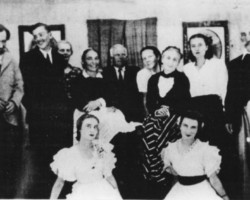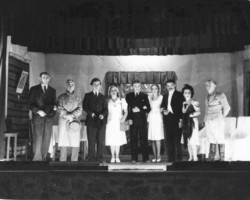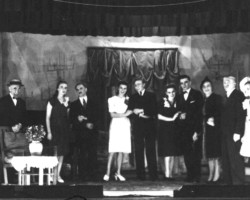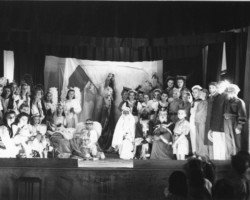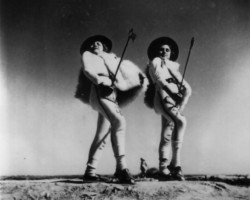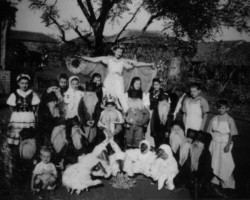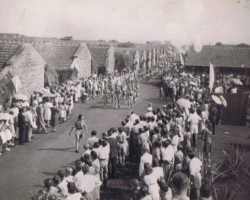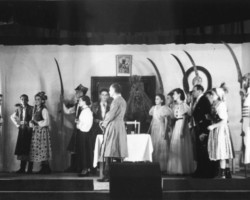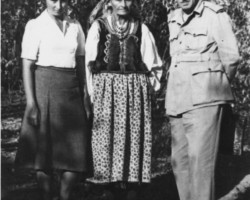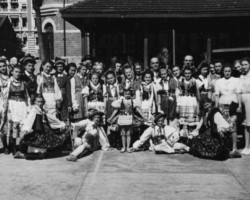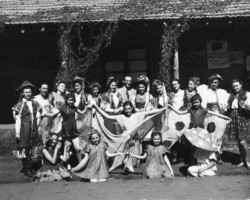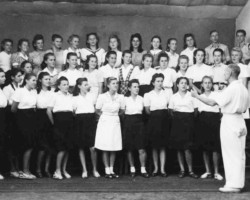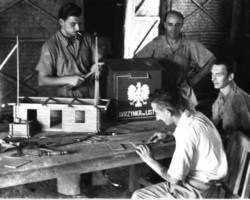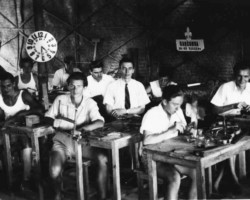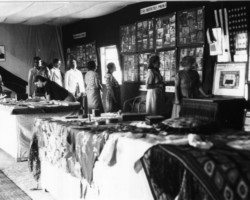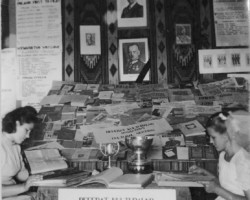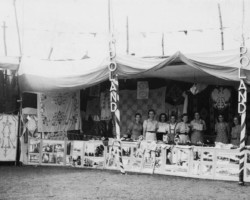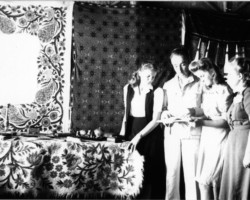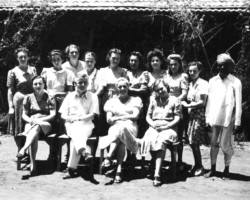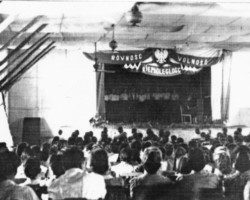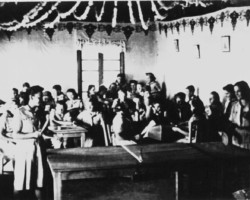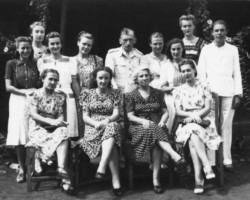Quick Links
Valivade – Cultural life
Among all the departments in the administration of the Valivade settlement, the Cultural and Educational Department (CED) played a not insignificant role. After organizing shelter for Polish refugees, there was still the need to satisfy the hunger for the Polish word and the intellectual needs of the settlement’s inhabitants. This was in line with the goals of the Delegation of the Ministry of Labor and Social Welfare, which understood how important this aspect was in the everyday life of refugees. Therefore, the task of the CED managers was great and responsible. It required broad horizons, deep culture, as well as ingenuity and a certain “flair” to start giving away from almost nothing from the treasury of native culture in harsh conditions, to change “into small change” so that there would be enough for all the inhabitants of Valivade, thrown far from their homeland.
The first director of the RKO was Michał Chmielowiec, soon afterwards appointed to Bombay as editor of the newspaper “Polak w Niechciał”. After him came MA Jadwiga Siedmiograj, then Major Ludwik Naimski, and finally from 1945 Janina Dobrostańska, an artist of Polish stage theatres, previously working in a settlement for Polish children in Balachadi. The next employees of the office were: Alicja Kisielnicka, Tatiana Pawłowska, Walentyna Tyszko, Zofia Poczobut-Odlanicka, Irena Świątkowska, Anna Sahanek, Wiesława Klepacka, Halina Jędrychowska, Weronika Feń; in the graphics department: Krystyna Biskupska, Janina Rymar, Henryka Gromadzka and Janina Gurgul – liaison. Indus Maruti also worked – he was “for everything”. The activities of the RKO included the following areas: a primary school for adults, a lecture and talk campaign, reading aloud to listeners, running a library, providing information and daily announcements, amateur theatre, music lessons, competitions, after-school activities and games for children, and courses.
After arriving in Valivade and settling in, 165 adults signed up for classes at the primary school, which is 14.8% of all adults (1,796 people), and 64 of them were over 55 years old… The course was initiated by Stefania Marasek, then led by Anna Skrzatowa, and the teachers were: Rypsyma Jankowska, Helena Martusewicz, Salesian Brother Jan Orysiuk, Wanda Siedmiograj, Jadwiga Topolnicka, Zofia Wilczyńska, Jadwiga Wróblewska, Zofia Zagórowska. As part of this primary school, a supplementary course was organized at the level of grades V and VI in the apprentice-master tailoring course, led by Józef and Anna Szarejko. Both classes were attended by 51 students. The adult program included learning Polish (reading and writing) and arithmetic up to 1000. This older and brave group of illiterate residents found the course extremely satisfying in the skills they had acquired in reading and writing Polish. The whole world suddenly opened up to them, as they later began to borrow books and read the daily announcement themselves.
Teachers and specialists from various fields volunteered to take part in the reading and discussion campaign, either conducting one-off 40-minute talks or cycles of 3-4 lectures. The readings were held in community centres and could gather up to 100 people. The daily press release was issued in 26 copies – printed from a wax paper by the previously mentioned Indus Maruti, who was persistent and conscientious in his work for the RKO. The release was posted on notice boards in several places in the housing estate, and over time it could be subscribed to for a monthly fee, and then it was delivered to home. All community centres also received it. The source of the information for the release was the radio broadcasts of Polish Radio on the waves of London and Voice of America from New York. Receiving this information was not easy, because it was often jammed not only by weather conditions, but also intentionally by hostile stations. Therefore, at least two people would take the wiretap, to then coordinate and complete the information before passing it on to the RKO the following morning. The preparation of the radio news for the Announcement was the responsibility of Antoni Birar, who also reported the news from the Times of India, published in Bombay, and the London-based Dziennik Polski and Dziennik Żołnierza. After the abolition of Polish Radio broadcasts on London airwaves, immediately after the British government recognized the communist government in Warsaw, the RKO introduced half an hour of live radio. As part of this broadcast, bulletins issued by the Delegation of the Ministry of Labor and Social Welfare in Bombay were read out, which at that time were the only real source of information about Polish affairs in the country and on the international stage. With the same aim in mind, the RKO organized a series of lectures devoted to the political situation in Poland.
As the estate expanded, community centers were established. This is where young and old people gathered in large numbers to spend time in a pleasant atmosphere. Community centers were a place for meetings, entertainment, and the peaceful use of the reading room and library, which grew quite quickly (at the end of the estate’s operation it had about 3,000 items), and books were fairly lent out by Jadwiga Kotlicka, the librarian from the beginning of the estate’s existence almost until the very end. In 1944, the estate had five community centers (in the later development of the estate, there were eight properly equipped community center rooms, three of which were intended for the elderly, the rest for young people and children). The beginning of community center work in the not yet equipped community center no. 1 was when Alicja Kisielnicka began to read aloud the trilogy by Henryk Sienkiewicz. The interest was enormous. Even before the opening hour, people hungry for the Polish word gathered in front of the community center. This prompted the management of the RKO to introduce aloud reading into the work of the community centers. Fairy tales were read to the children, and for some time the day-care workers even went to the hospital to read to the sick.
Community centre no. 1 occupied three rooms on two levels. The community centre “held office” in the first room, and there was a library and a reading room. On a raised platform in the second room stood a table tennis table, mostly used by young people; there were game cabinets and a table for handicrafts against the walls. During community centre events, the tables were moved to the walls and the room on the raised platform became a stage. The third room was reserved especially for older people and gathered bridge enthusiasts. The community centre of the educational institution (for orphans, half-orphans and children separated from their parents) was, for understandable reasons, very popular. It consisted of two rooms, one of which was used for doing homework. The Friends of the Soldier Circle was established in this community centre. Children established contacts with soldiers who were sick or injured in hospitals. Before Christmas, over a dozen letters with Christmas wafers were sent. Embroidered handkerchiefs were often attached to the letters. The literary group at this community centre took care of the wall newspaper, took on the task of keeping the institution’s chronicle and preparing events for the youngest children. Community centre no. 2 became a community centre exclusively for children. Later, it was transformed into a cub scout centre, run by two cub scout instructors: Zofia Dudkówna and Elżbieta Woyniłłowiczówna. In case of bad weather, the cubs would gather here for meetings, and the scouts gaining the skills of “child caretakers” had the opportunity to practically demonstrate their skills. Every month, each community centre held community evenings devoted to current topics. They usually consisted of a talk or lecture and an artistic part prepared by the community centre workers with the participation of the community centre regulars. This gave the young people the opportunity to show off their singing, reciting and often presenting their own compositions.
The club events also included lectures. A series of eight lectures by Professor Anna Handerek on topics such as Polish-Russian and Polish-German relations was popular. In addition, a number of current topics were used. Each national anniversary or holiday was commemorated with appropriate talks or, as in the Cub Scout club, a story. In addition, the clubs organized various types of competitions, including for the best decorated apartment or garden among Polish refugees, or for the most beautiful literary work of independent authorship.
Weekly political reviews by inspector Zdzisław Żerebecki about the course of the war, with a map showing the progress of war operations, informed the population of the estate about the ongoing war on various fronts of the world. But they were not the only lectures that were well attended. Others were also very popular. Children were not forgotten, and the day-care workers told them stories. The youth, in turn, organized various events in the day-care centers, such as St. Andrew’s Day fortune-telling.
Valivade also kept a chronicle of the settlement, which was strongly recommended by the MPiOS delegate Wiktor Styburski. The chronicle was started by Alicja Kisielnicka on behalf of the Cultural and Educational Department, and continued by Wiesława Klepacka. In their notes, the chroniclers tried to show the exotic background against which the life of the Polish settlement in India developed, to capture the most characteristic manifestations of this life. The chronicle was abundantly illustrated with photographs and diversified with clippings from the newspaper “Polak w Niechciał”. This newspaper regularly published excerpts from the Chronicle of the Settlement sent by the RKO. A newspaper from East Africa, edited in Nairobi (Kenya) for Polish settlements on that continent, also reached the refugees in Valivade. It was first “Polak w Afryka” subsidized by the Polish authorities, and later “Głos Polski” published on the basis of the Social Press Fund. In one of the first issues that reached Valivade, one could find lost acquaintances or members of broken families in the list of refugees from several sea transports from Karachi to East Africa. “Echo Szanghajskie” published by the Polish colony in China also reached India, and soon afterwards from the other end of Eurasia came the newspaper “Nowiny”, published since the end of the war in Europe by the Polish Liquidation Command in Germany.
At the beginning of 1944, thanks to the efforts of the District Office in cooperation with the Cultural and Educational Department, an exhibition was opened, providing information about pre-war Poland. Many similar exhibitions were opened, intended to present the homeland of refugees in Valivade not only to Poles themselves (out of longing, hope for return), but also to Indians and the British. Much was also done in this area by showing Polish folk products at various festivals or fairs in the city of Kolhapur, not far from Valivade.
The cultural life of the estate was complemented by concerts organized in cooperation with the management of the secondary school and high school. In the initial period, musical evenings were organized in the theatre hall of community centre no. 1. Maria Sahanek sat at the piano, Dr. Leon Koziełkowski played the violin, and Jan Kaśków and Władysław Fechter showed off their singing skills. Concerts in the camp cinema hall were very popular (apart from everything, the films shown there were also very popular). At the end of 1944, musical mornings for school youth were organized. Compositions by famous classics were presented, usually preceded by a lecture discussing their lives and the nature of their compositions. On 20 February 1946, on the 136th anniversary of Fryderyk Chopin’s birth, a special Chopin morning took place, the programme of which consisted of the composer’s compositions and declamations. The literary and musical evenings gathered not only local music lovers, but also English and Indian intelligentsia from Kolhapur and the surrounding area. The British could also admire the performances of the amateur theatre actors whose troupe was formed in the estate.
After the takeover of RKO by Major Ludwik Naimski, an amateur theatre was established in Valivade under his aegis. The plays were directed by Antoni Skomorowski, who himself took part in them. Before the war, he was an actor and director of the Soldier’s Theatre in Warsaw – a true man of the theatre. The group was recruited mainly from high school students, and later graduates, as well as a group of people of good will who loved theatre, singing and music. Revue and drama performances (including Act III of Stanisław Wyspiański’s “Wesele”) became the repertoire of young actors who passionately committed themselves to art. At the turn of 1945 and 1946, Janina Dobrostańska came from Balachadi to Valivade (in the Polish children’s settlement in Balachadi, under her care and guidance, artistic life flourished among the youth from Balachadi) and immediately enriched the amateur theatre with her professional contribution (as a real actress, performing in pre-war Poland on the stages of many theatres), and at the same time a great enthusiast of the stage. In her development and direction, “Nativity play” was staged during Christmas 1946, and later many other performances, such as “Gwałtu, co się dzieje!?” by Aleksandra Fredro.
This type of artistic life also flourished under the management of Alicja Kisielnicka. “Bajka Wschodnia” written by her was performed on a small stage in Valivade and with it the group travelled to Kolhapur, the capital of the principality, where in the palace of the local maharaja it was entertained by the young prince, the son of the local maharaja. In November 1943 a group of school youth gave a show of Polish dances in Bombay; the mazur and krakowiak choreographed by Tatiana Pawłowska and Maria Goławska, the highland dance choreographed by Maria Gimza delighted the audience. This was one of the points of the large-scale event within the framework of the propaganda of Polish culture. In the same year, “Snow White” and “Sleeping Beauty” were also performed.
